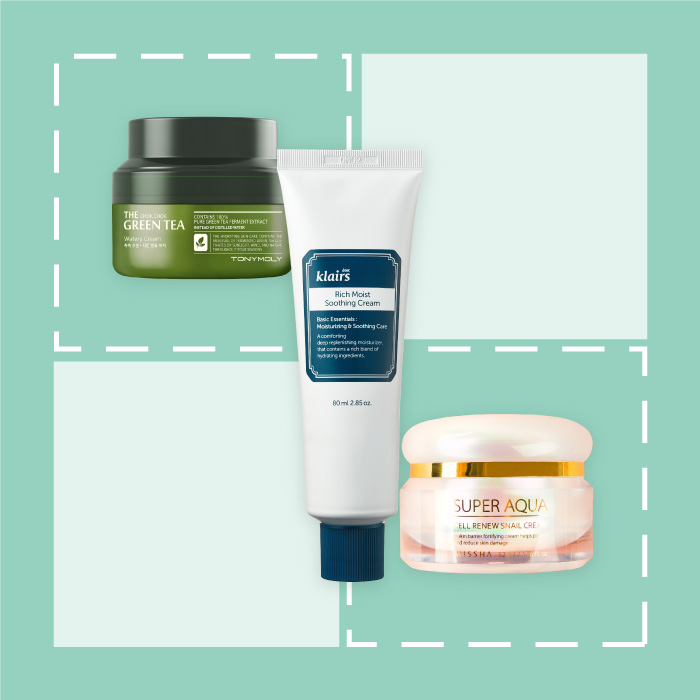Hello, and welcome to “How to Buy a Moisturizer 101.” Here, I’m teaching you a little trick that will help you get the absolute most out of your moisturizer.
*Edit: We have revised this article to clarify that water-based moisturizers have a place in the skin care world (they do!) but that there are other moisturizers that use equally hydrating ingredients as the first ingredient, or they use nutrient-packed water as the first ingredient*
I’m always down for genius tips that will help me shop smarter and use my money more efficiently. So, I’m here to share a pretty easy and groundbreaking tip that will have you looking at moisturizers differently. Ready? Here it goes: Before you buy a moisturizer, always look at the list of ingredients first.
Why? Because you want to watch out for fillers. The most important ingredients in any skin care product are the first five listed in the ingredient list. This is because ingredient lists are listed by order of predominance, meaning that the largest concentration of an ingredient is listed at the top and it moves down by amount.
Also, when you’re looking for a moisturizer, you shouldn’t always just be looking for something that only offers hydration. Sure, you should definitely be searching for moisture (it’s called moisturizer for a reason), but if you’re a smart shopper, you’ll know that a good moisturizer hydrates but also fortifies skin with hard-working ingredients that address certain skin issues.
So you may want to look for a moisturizer that avoids simply listing “water” as its first ingredient. That’s not to say that there’s no place for those moisturizers; if you have super dry skin, sometimes water is just what you need. Another reason to not think all water-based skin care is bad: Some actives, like tea tree extracts and fruit acids, work better when they are diluted by water. The fact is that all moisturizers need water or a hydrating oil to offer hydration and balance out the active ingredients in the formula.
But sometimes, moisturizers don’t have ingredients in them that need to be diluted or helped by the addition of water, and instead, they use different hydrating ingredients (or ingredient-boosted water) as the first one on the list. Here are three we’d like to highlight.
The Tony Moly Chok Chok Green Tea Watery Cream lists fermented green tea as its first ingredient. This means that the cream will not only hydrate skin, but treats it with an ample amount of fermented goodness.
This light cream from Tony Moly is high in antioxidants. Green tea works to moisturize skin, protect it from pollution and UV damage, and help brighten it for a more youthful-looking appearance. Along with antibacterial lemon seed oil and soothing rosewood oil, the product seeps into skin immediately and leaves it with a plump and soothed look and feel.
If you have drier skin, don’t worry. There’s another great cream you should try that doesn’t list simply water as the first ingredient. I’m talking about the tried-and-true Klairs Rich Moist Soothing Cream.
+The Klairs Rich Moist Soothing Cream has since been reformulated.
In fact, water isn’t listed as an ingredient at all in this cream. The first ingredient in this cream is capric triglyceride, which is basically a version of super-hydrating glycerin (a natural humectant), but made to work better for sensitive skin types. This ingredient helps skin attract water and balance the skin’s moisture content. It’s a blend of coconut oil and glycerin that contains a healthy mix of fatty acids that the skin uses to strengthen its barrier. This ingredient is what makes the Klairs Rich Moist Soothing Cream an amazing option for those with dry, sensitive skin.
Traditional glycerin, cetyl alchol, cyclopentasiloxane, glyceryl stearate, and sodium hyaluronate round out the rest of the top ingredients in this Klairs moisturizer, and all of these are rated as great ingredients for moisturizing skin, especially sodium hyaluronate, which is comprised of smaller molecules than traditional hyaluronic acid, making it able to penetrate pores better and deeply hydrate them.
Have oily skin and and acne scars? A great nutrient-packed moisturizer is the Missha Super Aqua Cell Renew Snail Cream.
The first ingredient in this gel-type cream is snail secretion filtrate, AKA snail mucin. You’ve probably heard us praise this ingredient many times, and sorry if it’s getting redundant, but snail mucin is one of the absolute best ingredients for rebuilding the skin’s barrier and helping heal and fade acne scars faster. It’s comprised of a huge collection of amino acids and vitamins that help bring skin back to its optimal health, helping shed dead skin cells and renew the complexion with new skin cells.
The fact that the first ingredient in this Missha cream is snail mucin means that when you dab this on your face, you’re truly imparting ingredients that are going to make a major change in your skin instead of simply hydrating it.
Bottom Line
We hope you enjoyed your first lesson in “How to Buy a Moisturizer 101.” Remember, always pay attention the first five ingredients listed on your moisturizer. It’s fine if it has water listed as the first ingredient (especially if there are acids in the formula), but it doesn’t hurt if the first ingredients in the product are nutritive ingredients or ingredient-infused water to give you extra benefits on top of hydration!
